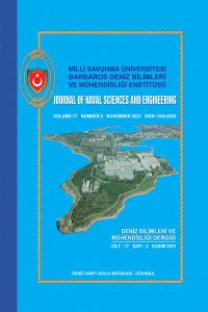FAKÜLTE ÖLÇEĞİNDE FOTOVOLTAİK SİSTEM TASARIMI VE ANALİZİ
Bu çalışmada, Giresun Üniversitesi Mühendislik Fakültesinin ihtiyaçlarına uygun fotovoltaik sistem tasarımı geliştirilmesi amaçlanmıştır. Fotovoltaik sistem için gerekli olan panel sayısı matematiksel denklemlerle tahmini olarak belirlendikten sonra PVSol programı kullanılarak Mühendislik binası çatılarında 3 boyutlu olarak yerleşim planlaması yapılmış ve sistem için gerekli olan ekipmanlar belirlenmiştir. Fotovoltaik sistemin simülasyonu gerçekleştirildikten ve sisteme uyumlu ekipmanlar belirlendikten sonra PVSol simülasyon programı yardımıyla maliyet hesaplamaları, finansal analizleri ve sistemin kendini amorti etmesi gibi farklı parametreler belirlenmiş olup sonuçları analiz edilmiştir.
Anahtar Kelimeler:
Yenilenebilir Enerji, Güneş Enerjisi, Enerji Üretimi, Fotovoltaik
PHOTOVOLTAIC SYSTEM DESIGN AND ANALYSIS AT FACULTY SCALE
In this study, it is aimed to develop a suitable photovoltaic system design for the needs of Giresun University Faculty of Engineering. After the determination of the number of panels required for the photovoltaic system by mathematical equations, a 3-dimensional layout planning was made on the roofs of the Engineering building using the PVSol program thus the required equipment was determined for the system. After simulation of the photovoltaic system and determination of the equipment compatible with the system was done, some parameters such as cost calculations, financial analysis and self-paying of the system were determined by the PVSol simulation program and the results were analyzed.
Keywords:
Renewable Energy, Solar Energy, Power Generation, Photovoltaic,
___
- Chiu, C.-L., and Chang, T.-H. (2009). “What proportion of renewable energy supplies is needed to initially mitigate CO2 emissions in OECD member countries?” Renewable and Sustainable Energy Reviews, Vol. 13, Issues 6-7, 1669-1674. doi:10.1016/j.rser.2008.09.026.
- Ellabban, O., Abu-Rub, H., and Blaabjerg, F. (2014). "Renewable energy resources: Current status, future prospects and their enabling jktechnology". Renewable and Sustainable Energy Reviews, Vol. 39, 748-764. doi:10.1016/j.rser.2014.07.113.
- General Directorate of Energy Affairs (n.d.). "Güneş Enerjisi Potansiyel Atlası (GEPA)”. Retrieved from https://gepa.enerji.gov.tr/MyCalculator/pages/28.aspx
- International Energy Agency (2011). "Solar Energy Perspectives: Executive Summary". International Energy Agency (IEA). Archived from the original (PDF) on 13 January 2012.
- Masterson, V. (2021, 05 July). "Renewables were the world’s cheapest source of energy in 2020, new report shows". World Economic Forum. Retrieved from https://www.weforum.org/agenda/2021/07/renewables-cheapest-energy-source/?utm_source=twitter&utm_medium=social_scheduler&utm_term=Future+of+Energy&utm_content=07/07/2021+00:00
- Ministry of Energy and Natural Resources of Republic of Turkey (n.d.). “ Güneş Enerjisi”. Retrieved from www.enerji.gov.tr/gunes-bilgimerkezi
- Sulukan, E. (2020). “Techno-economic and environmental analysis of a photovoltaic system in Istanbul”. Pamukkale University Journal of Engineering Sciences, 26(1), 127-132.
- Turkish State Meteorological Service (MGM) (n.d.). “Türkiye Ortalama Güneşlenme Süresi (1991 -2020)”. Turkish State Meteorological Service (MGM). Retrieved from https://www.mgm.gov.tr/kurumici/turkiye-guneslenme-suresi.aspx
- Turkish Statistical Institute (TÜİK) (2020, 31 March) “ Sera Gazı Emisyon İstatistikleri, 1990-2018”. TÜİK News Bulletin, No. 33624. Retrieved from https://data.tuik.gov.tr/Bulten/Index?p=Sera-Gazi-Emisyon-Istatistikleri-1990-2018-33624
- Valentin Software (2020). “The design and simulation software for photovoltaic systems”. Retrieved from https://valentin-software.com/en/products/pvsol-premium/
- Varlık Günüşen, İ., and Yılmaz, A. (2017). “Türkiye Ekonomisinde Yenilenebilir Enerji Projelerinin Gerçekleştirilmesinde Sorunlar ve Çözüm Önerileri”. Finans Politik & Ekonomik Yorumlar, Vol. 54, Issue 623, 51-62.
- ISSN: 1304-2025
- Yayın Aralığı: Yılda 2 Sayı
- Başlangıç: 2003
- Yayıncı: Milli Savunma Üniversitesi Deniz Harp Okulu Dekanlığı
Sayıdaki Diğer Makaleler
UME KİBBLE BALANS – 3 İLE TEK FAZDA ÖLÇÜM
Ercan KURU, Tolga ÖNEL, Mehmet Bilge Kağan ÖNAÇAN, Musa MİLLİ
TİP-3/2 TAHTAREVALLİ MEKANİZMASINDA NÖTRİNO KÜTLESİNE GELEN IŞINIMSAL DÜZELTMELER
Mehmet Bilge Kağan ÖNAÇAN, Volkan SEZGİN, Tunç Durmuş MEDENİ, İhsan Tolga MEDENİ
FAKÜLTE ÖLÇEĞİNDE FOTOVOLTAİK SİSTEM TASARIMI VE ANALİZİ
